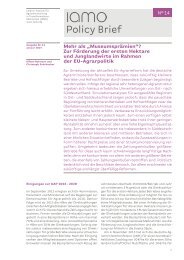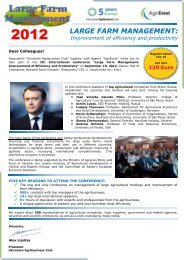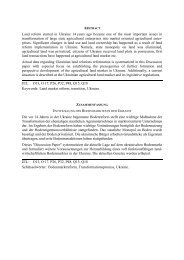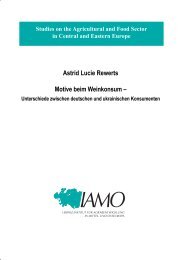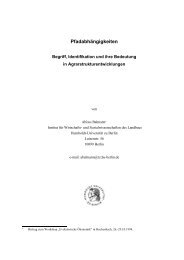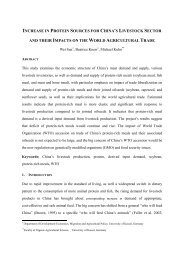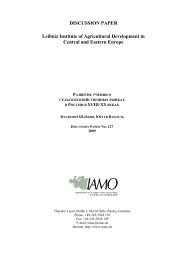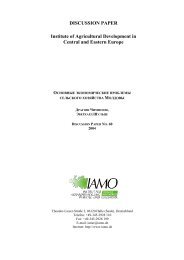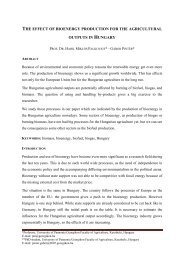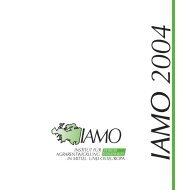Abstract - IAMO
Abstract - IAMO
Abstract - IAMO
You also want an ePaper? Increase the reach of your titles
YUMPU automatically turns print PDFs into web optimized ePapers that Google loves.
14 ANDREAS WILDERMUTH<br />
The means commonly applied by insurance companies for spreading their risks is to enter into<br />
reinsurance contracts with international reinsurers, in conjunction with the management of<br />
reserves. Some of the proponents of the first line of argument take the view that private<br />
reinsurers cannot be expected to provide the necessary reinsurance. QUIGGIN (1994, p. 117)<br />
e.g. argues that only the state can be expected to have a sufficiently large and diversified<br />
portfolio of assets to provide reinsurance cover for large-scale multiple-peril crop insurance.<br />
MIRANDA and GLAUBER (1997, pp. 209-210) quote KRAMER (1982) to assert that the<br />
historical record shows that a private crop insurance industry cannot develop anywhere in the<br />
world solely around the risk management services provided by major reinsurers. They argue<br />
that reinsurers, despite their larger size and better portfolio diversification, ultimately face the<br />
same limitations as a primary insurer because they, too, are designed to deal with idiosyncratic<br />
diversifiable risk only. According to MIRANDA and GLAUBER (1997) this makes them<br />
incapable of coping with the huge losses associated with, say, a widespread drought.<br />
Two points merit attention. First, even if QUIGGIN (1994) and MIRANDA and GLAUBER (1997)<br />
are right, their arguments can justify only the provision of reinsurance by the state, but not<br />
large-scale subsidisation of multiple-peril or all-risk crop insurance. Second, the assertion that<br />
insurance companies insuring covariate crop yield risk cannot obtain reinsurance cover for<br />
their portfolios does not necessarily hold for insurers that restrict their coverage to few perils,<br />
even if the losses caused by these perils are characterised by strong positive correlation across<br />
farmers. There are examples of unsubsidised public-sector crop insurance schemes insuring<br />
sugar farmers against the risks of cyclones (in Mauritius) and banana farmers against the risk<br />
of hurricanes (in the Windward Islands). These companies manage to do so without state<br />
support because they reinsure most of their risk. Another example is the Chilean voluntary<br />
private-sector crop insurance scheme, which covers risks like drought and flood in cereal<br />
production. Right from the start of the scheme the Chilean insurer reinsured most of its risk<br />
(ROBERTS and DICK 1991, pp. 45-60, 93-108, 135-144). The reason why this is possible is<br />
simple and has been overlooked by MIRANDA and GLAUBER (1997). Although the reinsured<br />
risks are to a large extent systemic to the agricultural sectors of Mauritius, the Windward<br />
Islands and Chile, they are idiosyncratic on a world-wide scale and therefore reinsurable. The<br />
same holds for other crop yield risks, provided they are idiosyncratic on a world-wide scale.<br />
The apparent impossibility of unsubsidised multiple-peril and all-risk crop insurance must,<br />
therefore, have other reasons.<br />
The next issues we will discuss are the problems of asymmetric information. Consider adverse<br />
selection first. As BINSWANGER (1986, pp. 77-78) has pointed out, the insurer faces a<br />
fundamental trade-off between information costs and incentives. Given initial asymmetric<br />
information between the insurer and the farmer, an insurer wanting to avoid adverse selection<br />
right from the beginning of the scheme would have to carry out actuarial calculations to<br />
to be borne by the farmer himself, if they are below 8% of the no-hailstorm yield (HILDEBRANDT 1988, pp.<br />
280-281; N.N. 1994; N.N. without year). This type of insurance contract comes very close to the ideal Paretooptimal<br />
insurance contract between a risk-neutral insurer and a risk-averse insured that has been derived by<br />
RAVIV (1979) for the case of symmetric information and costs that are independent of the size of the indemnity.<br />
In this case all risk is borne by the insurer, the insured gets full insurance. The slight deviations from full<br />
insurance can easily be explained with other results of optimal insurance theory, again, always assuming a riskneutral<br />
insurer. As GOLLIER (1987) has shown, non-indemnification of small losses is part of a symmetric<br />
information first-best insurance policy if loss adjustment entails positive costs that are independent of the size<br />
of the loss. A result in WINTER (1992. pp. 75-78,90-91) shows that the upper limit on indemnities (here 125%<br />
of the sum insured) can be part of an insurance policy if there is moral hazard on loss-reduction.



